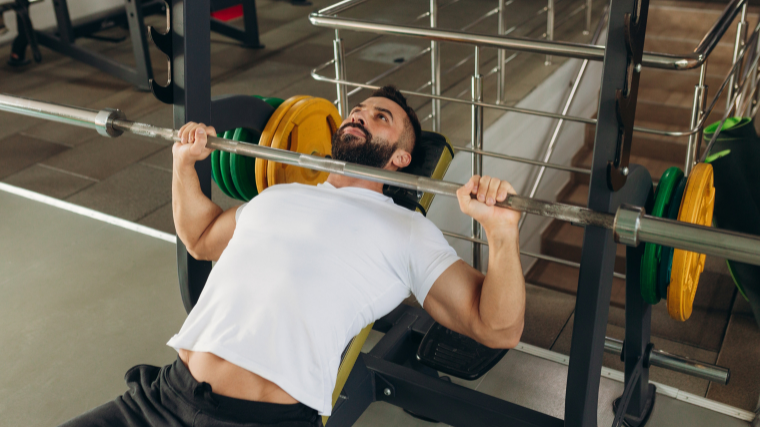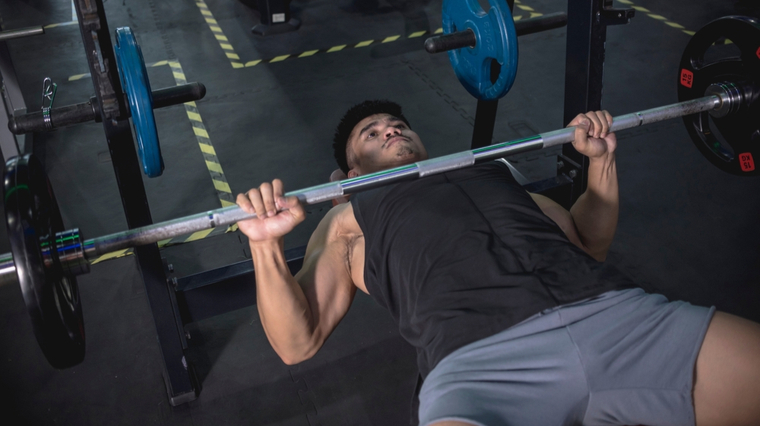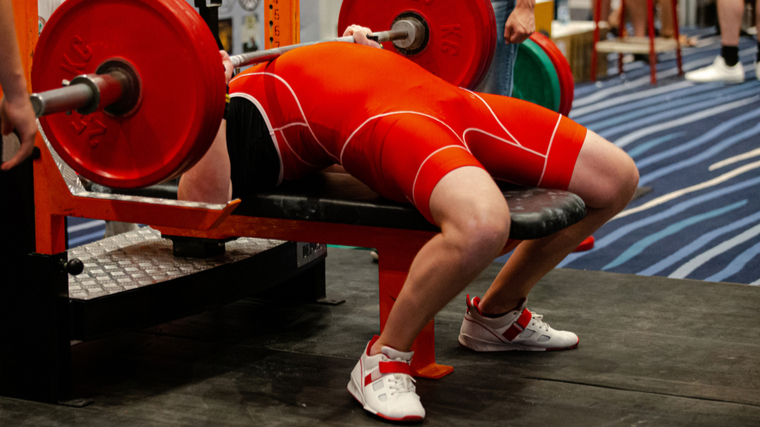The barbell bench press can be woven into the programming of nearly every lifter. From bodybuilders, powerlifters, or just gym bros reliving their high school glory days — the “how much ya’ bench?” talk is almost unavoidable; but, dramatically less talked about is what makes an effective bench press warm-up.
Complaints of alleged bench press induced shoulder pain, plateaus, or injury seem just as common as comparing personal bests; however, you can sidestep many of these potential pitfalls with proper preparation.

A smart and consistent warm-up will assure that the bench press continues to help your progress rather than hinder it. Here is the only bench press warm-up that you’ll ever need.
Your Bench Press Warm-Up (and Beyond)
- Best Bench Press Warm-Up
- What Makes a Good Warm-Up?
- Benefits of Warming Up
- How to Do the Bench Press
Editor’s Note: The content on BarBend is meant to be informative in nature, but it should not be taken as medical advice. When starting a new training regimen and/or diet, it is always a good idea to consult with a trusted medical professional. We are not a medical resource. The opinions and articles on this site are not intended for use as diagnosis, prevention, and/or treatment of health problems. They are not substitutes for consulting a qualified medical professional.
Best Bench Press Warm-Up
In order to create your warm-up, you should break the bench press down into the specific positions you’ll need to get into. According to Dr. Jordan Shallow, strength coach, chiropractor, and founder of Pre-Script™, many bench press woes begin because of an inability to maintain adequate thoracic spine mobility, shoulder mobility, or stability. He recommends completing your warm-up routine as part of a circuit to be as efficient as possible.
Step 1 — Thoracic Spine Mobility
Regardless of your bench press goal, there should be a natural arch produced through your thoracic spine while you press. Powerlifters may aim to create a more pronounced arch as a method of improving competitive performance.

In either of these instances, starting with a brief thoracic spine mobilization using a foam roller is a convenient way to assure your mid to upper back will move how you need it to in your set up.
Perform 10-20 foam roller passes from your mid to upper back.
Or, Try the Dumbbell Pullover
The dumbbell pullover is a great alternative to simple thoracic spine foam rolling. Foam rolling works, but you may end up preferring an alternative that utilizes weight as a cue to better control your position throughout the range of motion.
Simply grab a light-to-medium weighted dumbbell and perform a glute bridge on a flat bench — while supporting yourself in a bridge position, hit the dumbbell pullover for 10-12 repetitions.
Step 2 — Shoulder Mobility
The next step of your warm-up will be to assure that your shoulders can move in all the ranges of motion you need before hitting the bench press. This means being able to protract and retract the shoulder blades while also being able to get overhead without incident. A solid face-pull can be quite effective at integrating these ranges of motion.
Using long-handled rope attachments, fully protract your shoulder blades (reaching forward), pull back on the ropes drawing the handles towards your face, and finish by sweeping the handles above your head.
If things still feel a bit tight, try stretching your pecs or lats using a doorway stretch or dowel-assisted prayer stretch, respectively.
Perform 12-15 repetitions of the face-pull.
Or, Try this Band Superset
If a face-pull doesn’t float your boat, a nice alternative will be to combine band pull-aparts with band shoulder dislocations. Simply combine these two low-intensity exercises as a superset with high repetitions to get a great mobilizing effect for the shoulders.
Perform both exercises with a light-to-medium band for 12-15 repetitions.
Step 3 — Stability
Once you have added some mobility to your thoracic spine and shoulders, it’s a good idea to cue stability before hitting the bench itself. Excessive or uncontrolled ranges of motion can be just as detrimental as not being mobile to begin with. Perform a bottom-up kettlebell press to really cue your shoulder stability.
Sets of 10-12 repetitions with a moderate weight should work here.
Or, Try the Kettlebell Windmill
The kettlebell windmill is an advanced version of the stimulus you’ll get from the bottom-up kettlebell press. The windmill introduces more full body coordination and a rotational challenge, meaning you’ll check even more mobility and stability boxes with the same exercise. That said, it might take some time to get good enough to consistently perform.
Try a set of 5-10 repetitions per side with a light-to-moderate weight.
Step 4 — Ramping Sets
The final step of your circuit should be with the bench press itself. The key to a good warm-up is to get immediate feedback from your bench press performance. After completing one set of each of the previous warm-up steps, perform a warm-up set of bench presses with just the empty barbell.

Once everything feels locked in and grooved properly, ramp up the weight a bit at a time until you’re at your workout weight.
Sets of 3-5 repetitions beginning with the empty bar and gradually ramping up to your working weight will help prepare you for the sets ahead.
What Makes a Good Warm-Up?
A good warm-up improves the future performance of the main exercise you’re trying to complete. Each lifter will experience different challenges for the barbell bench press.
Whether you’re into bodybuilding, powerlifting, or simply learning to move well, your specific needs should be addressed by the warm-up before you ever get your hands dirty with the bar.
For Beginners
A beginner has two priorities when it comes to the bench press; learning the technique and adding strength or muscle. Learning the skill means making your sets and repetitions as similar to each other as possible — from the warm-ups all the way through to the main working sets.
Take your time with your circuit and warm-up sets to assure you’re learning the correct form and creating balanced muscle recruitment.
A second valuable tool with a properly designed warm-up is the addition of “free volume” to build some much needed muscle. Selecting warm-up exercises like the dumbbell pullover or face-pull can be quite helpful in developing muscle tissue in addition to preparing you for the bench press itself.
For Bodybuilders
If you’re into bodybuilding, your warm-up should help you bolster your mind-muscle connection and range of motion before hitting the bench press. These two goals can be dramatically improved by employing modest tempo or pauses in the fully contracted position during the warm-ups.
Establishing a keen awareness of your body in space before laying down on the bench is a crucial part of maximizing muscle gain using a barbell, so you’re not just pressing absentmindedly. Make sure you’re putting the tension where it belongs — right on your pecs.
For Powerlifters
If you’re a powerlifter performing the bench press, the largest possible weight on the bar is your primary focus. There are many overlapping principles between warming up as a beginner and warming up as a powerlifter (executing the basics competently come to mind).
The ability to replicate your technique during each set, repetition, and training session is essential, no matter how heavy you’re lifting.

You should therefore emphasize pauses on your warm-up sets and develop maximum full body tension with eccentric tempo during each warm-up step. This way you will keep your bench press in training as similar as possible to competitive environments.
Benefits of Warming Up
A good warm-up should help mobilize any ranges of motion needed for the exercise of the day, provide skilled practice of the actual exercise with lighter loads, and help establish what you’re capable of doing on any given training session.
Healthy Mobilization
Training (and everyday life) will slowly adjust the way you move. Bodybuilders gain more muscle, powerlifters specialize in very specific movements, while your desk job or daily activity outside the gym may also impact your posture.
None of these things are inherently bad (or permanent), but it does mean that before you try to bench press, a good warm-up will attempt to hit the “reset button” on your mobility and get you into fighting shape.
Mobilizing your joints to be able to hit the ranges of motion necessary to bench press (particularly the thoracic spine and shoulders) should help keep you pressing without hitting plateaus while removing much of the general stiffness that’s accumulated throughout the day.
Practice Repetitions
The bench press (along with the many other barbell exercises) are skills. They require a coordinated effort of many muscle groups to safely execute, especially when taking a set close to failure. With that in mind, they are different from a machine with respect to the fact that you are solely responsible for guiding the barbell — there are no cables or locked-in ranges of motion.
As you warm up, using a practice set with a reduced load and working your way up to the weight of the day is a fantastic way to assure that you’re executing each set as perfectly as possible when it really matters.
Easy Autoregulation
Autoregulation describes making a judgment call on any given day of training. Whether your goal is to hit a set of five, eight, or 10 reps, you might not be able to necessarily guarantee a specific weight ahead of time.
Daily fatigue, stress, or any number of other factors could affect your performance. Warm-up sets give you valuable tactile feedback about your body and strength potential. For instance, if your warm-ups (which are normally light) feel oddly heavy on a given day, it might be wise to dial back your working weights temporarily.
How to Do the Bench Press
Once you’re fully warmed up and locked in, it’s time to actually bench. In case you’re in dire need of a refresher course, check out this collaboration between BarBend and world-record-holding powerlifter Taylor Atwood:
[Read More: The Best Upper Body Exercises and Workouts]
If you prefer things on paper instead of in pixels, here’s a handy step-by-step written guide:
Step 1 — Lie Down and Grip
Lay down flat on the bench with the bar resting in the rack positioned approximately at the bridge of your nose. Reach up to the bar and assume a comfortable grip about shoulder-width (or slightly wider) apart.
Step 2 — Set Your Back
While gripping the bar, slide yourself behind the rack and assume a seated position (do not let go of the bar). From here, slide back onto the bench using the barbell itself to help position you into a natural arch. Once you have found a comfortable level of thoracic spine arch, squeeze your shoulder blades together and down to reinforce this position.
Step 3 — Unrack and Brace
Draw the bar out from the rack and over your chest comfortably, squeezing your hands and keeping full body tension the entire time. Utilize a spotter to assist with the unracking motion if possible, or if you’re lifting particularly heavily.
Step 4 — Descend
Slowly lower the bar to your chest. Depending on your mobility and goals, you may touch the bar to your chest or hover it slightly above — but ensure that you are only utilizing a load and range of motion that is safe for you.
As you slowly lower the weight, think about keeping your torso “high” — this should help keep your torso as tight as possible and maintain your arch. Utilize tempo on the eccentric where necessary to keep the bar under control.
Step 5 — Press, Powerfully
Press the bar back towards the starting position. Stabilize your full body by utilizing your legs and reinforcing the back tension you generated during the descent while you press. Prevent your hips from rising from the bench by positioning your legs close to the bench itself and squeezing your glutes.
The bar’s path should drift both up and backward such that the rep ends with the implement directly over your shoulder joint.
Bolster Your Bench
The bench press is often more complicated than people think. It is a coordinated movement that combines upper body strength with lower body stability — offering different challenges to each body type and goal. With that in mind, the best warm-ups are able to cover all the bases and ensure your performance is on point (and consistent) day after day.
Place the right amount of effort behind a solid warm-up before your next bench press session and you’ll experience the immediate difference it can make.
Featured Image: Egora_Shmanko / Shutterstock